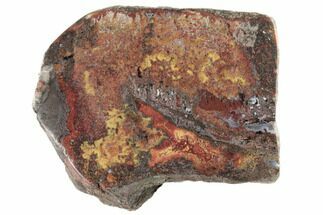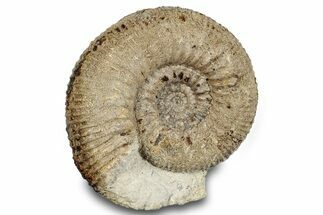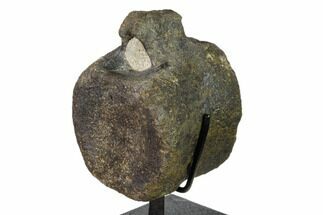This Specimen has been sold.
3.9" Brilliant Ammolite (Fossil Ammonite Shell) - Mosasaur Bite Marks!
This is an incredibly beautiful section of brilliant, iridescent ammolite from the Bear Paw Shale of Alberta, Canada. It features striking orange, yellow, red, blue, purple (rare), and green hues that shimmer differently depending on what angle the specimen is viewed from.
This section of the ammonite contains some of the outer and inner portions, with ammolite preservation along both sides of the ammonite. The inner chamber pockets are visible along two sides and one ammolite lined face of this specimen exhibits clear impressions of bite marks from a large marine reptile, most likely from a known ammonite muncher, a mosasaur!
It is accompanied by an acrylic display stand for sturdy, 360 degree display.
This section of the ammonite contains some of the outer and inner portions, with ammolite preservation along both sides of the ammonite. The inner chamber pockets are visible along two sides and one ammolite lined face of this specimen exhibits clear impressions of bite marks from a large marine reptile, most likely from a known ammonite muncher, a mosasaur!
It is accompanied by an acrylic display stand for sturdy, 360 degree display.
About Ammolite
Ammolite is an opal-like gemstone found primarily in Alberta, Canada. It is a kind of fossilized shell from ammonites, which in turn are composed primarily of aragonite, the same mineral contained in nacre (mother-of-pearl). The shell's microstructures are often preserved. In 1981, ammolite was given official gemstone status by the World Jewellery Confederation (CIBJO).
An iridescent opal-like play of color is shown in fine specimens, mostly in shades of green and red; howver, all the spectral colors can be seen. This iridescence is due to the aragonite's microstructure: unlike most other gems, whose colors come from light absorption, the iridescence in ammolite comes from interference with the light that rebounds from stacked layers of thin platelets that make up the aragonite. The thicker the layers, the more reds and greens are produced; the thinner the layers, the more blues and violets predominate. Blues and especially purples are the rarest colors, owing to the greater fragility of the finer layers responsible for these colors.
Ammolite is an opal-like gemstone found primarily in Alberta, Canada. It is a kind of fossilized shell from ammonites, which in turn are composed primarily of aragonite, the same mineral contained in nacre (mother-of-pearl). The shell's microstructures are often preserved. In 1981, ammolite was given official gemstone status by the World Jewellery Confederation (CIBJO).
An iridescent opal-like play of color is shown in fine specimens, mostly in shades of green and red; howver, all the spectral colors can be seen. This iridescence is due to the aragonite's microstructure: unlike most other gems, whose colors come from light absorption, the iridescence in ammolite comes from interference with the light that rebounds from stacked layers of thin platelets that make up the aragonite. The thicker the layers, the more reds and greens are produced; the thinner the layers, the more blues and violets predominate. Blues and especially purples are the rarest colors, owing to the greater fragility of the finer layers responsible for these colors.
SPECIES
Placenticeras sp.
LOCATION
Korite Ammolite Mine, SW Alberta, Canada
FORMATION
Bearpaw Formation
SIZE
3.9 x 2.2 x 2"
CATEGORY
ITEM
#293324
We guarantee the authenticity of all of our specimens.
 Reviews
Reviews













